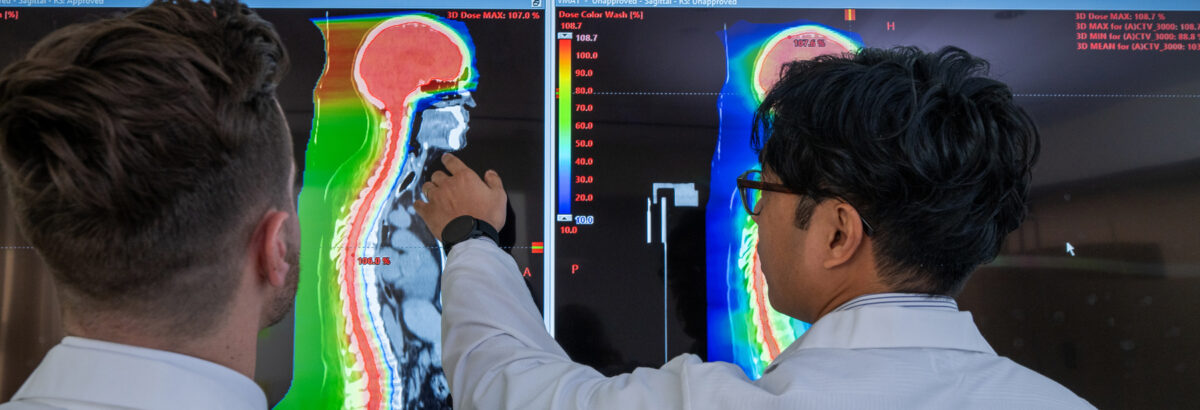Proton Therapy vs. Traditional Radiation
For men with prostate cancer, the side effects of conventional radiation treatment (including CyberKnife/SBRT) can have important quality of life implications—especially relating to urinary, gastrointestinal, and erectile function—as the organs controlling these functions also receive a lot of unnecessary radiation. Alternatively, proton therapy delivers considerably less radiation to healthy organs and tissues resulting in less frequent and/or less severe side effects, and often no side effects at all.
Proton therapy is particularly beneficial for men with high-risk prostate cancer that has spread or is at risk of spreading to the lymph nodes. Compared to conventional treatment, proton therapy can deliver high radiation doses to the lymph nodes while better sparing the healthy bowel and bladder.
Additionally, prostate tumors treated with proton therapy reduce the risks of secondary cancers in the treated areas. Proton therapy is also effective in treating patients with prostate cancer that has returned after previous radiation therapy or prostatectomy.
Proton therapy is outpatient, noninvasive and totally painless. The majority of patients continue on as normal, without having their quality of life throughout treatment impacted by their proton therapy. Entire treatment courses in only five days with proton SBRT and novel clinical trials are offered to appropriate candidates.
Fewer Side Effects
Proton therapy kills prostate cancer cells with a very high radiation dose. But because the protons are also highly targeted and are customized to travel to a specified depth in the body and then stop, they deliver more radiation to the prostate cancer and less to healthy organs surrounding the prostate gland, like the rectum, bowel, and bladder. As a result, proton therapy minimizes the likelihood of side effects and can better preserve your quality of life.
Accelerated Prostate Cancer Treatment Course
5-fraction SBRT proton therapy at the New York Proton Center did not disrupt Lamont’s busy schedule. Instead, his experience has led him to raise awareness about the importance of early detection in prostate cancer.
Types of Prostate Cancer Treated at the New York Proton Center
The New York Proton Center treats the following prostate cancers with proton therapy.
Localized prostate cancer (very low, low, intermediate and high risk)
Localized prostate cancer includes stage 1, stage 2, and stage 3 cancer that has not grown into nearby tissues or more distant body parts. There are three types:
– Very-low-risk and low-risk prostate cancer, each of which are unlikely to grow or spread for a long time, if at all.
– Intermediate-risk prostate cancer, which may grow or spread in a few years.
– High-risk prostate, which has the highest likelihood of spreading and, even after treatment, recurring.
Lymph node-positive prostate cancer
Prostate cancer will sometimes grow quickly and spread to lymph nodes, pea-sized pieces of tissue that filter a waste product called lymph. When this happens, a larger area needs to be targeted for treatment that includes the prostate gland and the lymph nodes. Proton therapy is particularly beneficial when treating large areas in the pelvis.
Postoperative prostate cancer
Data suggest that men who have undergone prostatectomy for prostate cancer may benefit from follow-up treatment with proton therapy, depending on several factors:
– Gleason score
– Seminal vesicle and lymph nodes involvement
– PSA levels
Recurrent prostate cancer
Among men treated for prostate cancer, up to 30 percent see their cancer return. Fewer than half of them can be cured by traditional treatment.
Proton therapy can treat these “recurrent” tumors more safely than other methods, giving patients a better chance for a cure.
Prostate Cancer Proton Therapy FAQs
Read our frequently asked questions about proton therapy for prostate cancer.
Pencil Beam Scanning: Highly advanced proton therapy for prostate cancer
At the New York Proton Center, patients with prostate and other genitourinary cancers receive Pencil Beam Scanning. It’s the most sophisticated and precise type of proton therapy.
Pencil Beam Scanning allows clinicians to create a highly customized treatment field based on the unique shape, size and location of the prostate cancer tumor—similar to traditional proton therapy, only with even greater precision.
As the name implies, Pencil Beam Scanning uses an extremely narrow beam—just a few millimeters wide—to “dot” protons onto the cancer. The process is repeated, layer by layer, like paint applied by the tip of an incredibly fine brush. The treatment is ultra-precise, capable of closely regulating the radiation dose according to the volume of the tumor.
A Tailored Approach to Treating Prostate Cancer With Proton Therapy
Many other proton centers treat prostate cancer with volumetric beams that deliver a fixed quantity of energy to the entire tumor and surrounding normal tissues. But the Pencil Beam Scanning technology available at the New York Proton Center uses “intensity-modulated proton therapy,” or IMPT.



